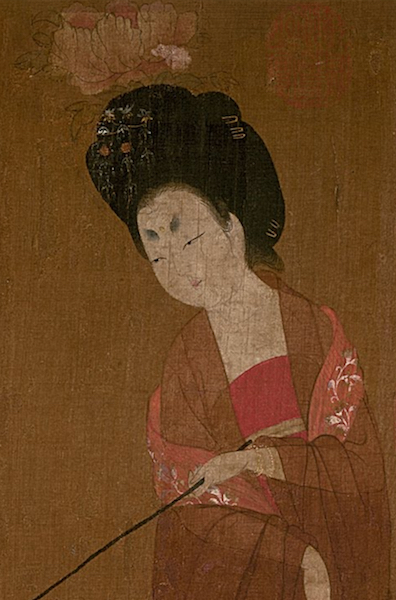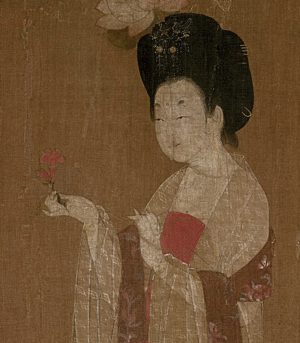
Attributed to Zhou Fang, Ladies Wearing Flowers in Their Hair, c. late 8th–early 9th century, handscroll, ink and color on silk, 46 x 180 cm (Liaoning Provincial Museum, Shenyang province, China)
“The beautiful woman” genre of Chinese painting
Throughout the history of Chinese art, painters never tired of adopting beautiful female figures as the subject of their depictions. With a stable political structure, flourishing economy, and prosperous culture, the genre of “beautiful women painting” (meirenhua) enjoyed high popularity and reached significant achievement in the Tang dynasty.
Born into an aristocratic family in Chang’an (the modern city of Xi’an), Zhou Fang is a well-known Tang court artist who painted in this genre. Even though it is not signed, Ladies Wearing Flowers in Their Hair, now kept in the Liaoning Provincial Museum in Shenyang, is traditionally attributed to Zhou Fang. It demonstrates how pictures of beautiful women can provide insight into ideals of feminine beauty and the social customs of the Tang dynasty. This horizontal scroll portrays five palace ladies and a maidservant amusing themselves in a garden scene. In the first section, two court ladies play with an adorable dog, one teasing it with a duster.

Two court ladies play with a dog (detail), attributed to Zhou Fang (active late 8th–early 9th century), Ladies Wearing Flowers in Their Hair, handscroll, ink and color on silk, 46 x 180 cm (Liaoning Provincial Museum, Shenyang province, China)
In the middle section, a third palace lady rendered in a hierarchal scale (depicted larger because of her higher status) is followed by a maidservant holding a long-handled fan. She gazes at a red flower that she holds in her hand and prepares to adorn her hair with it. A crane passes in front of the lady.

Court lady and her maidservant (detail), attributed to Zhou Fang (active late 8th–early 9th century), Ladies Wearing Flowers in Their Hair, handscroll, ink and color on silk, 46 x 180 cm (Liaoning Provincial Museum, Shenyang province, China)
Another court lady shown in a relatively small size strolls nearby with her hands clasped, adding a sense of depth and variation to the composition of the scroll. Beside a blooming magnolia tree growing next to a garden stone, the last lady in the picture catches a butterfly and her attention shifts to a dog that appears to be running toward her. Representations of the leisure and amusements enjoyed by aristocratic women can be seen as a reflection of their idle and carefree life in the palace.

Attributed to Zhou Fang (active late 8th–early 9th century), Ladies Wearing Flowers in Their Hair, handscroll, ink and color on silk, 46 x 180 cm (Liaoning Provincial Museum, Shenyang province, China)

Court lady (detail), attributed to Zhou Fang (active late 8th–early 9th century), Ladies Wearing Flowers in Their Hair, handscroll, ink and color on silk, 46 x 180 cm (Liaoning Provincial Museum, Shenyang province, China)
In the Tang dynasty, a voluptuous body represented the ideal of feminine beauty. Zhou Fang’s portrayals of court ladies in the scroll are characterized by round faces and plump figures. Their eyebrows are painted in the shape of butterfly wings and they display slender eyes, full noses, and small, cherry-like mouths. Their hairstyle is done in a high bun adorned with delicate gold ornaments and artificial blossoms such as peonies or lotuses. The ladies’ fair complexion comes from the white pigment that was applied to their skin.
The court ladies are gracefully dressed in long, loose-fitting gowns covered by transparent gauzes and scarves—all fashionable at the time. Their costumes of red, white, or ocher hues are exquisitely decorated with repeated floral, cranes, or geometric motifs that highlight the artist’s meticulous care and sophisticated skill in painting this subject.
Under Zhou’s brush, the plump bodies, facial traits, fair complexions, distinctive garments, and rich adornments together express the particular sense of the beauty and extravagance associated with aristocratic women of the Tang dynasty, and at the same time demonstrate broader aesthetic preferences for feminine beauty during this period. The artist’s contemporaries tended to favor similar portrayals of women—who functioned as symbols of the wealth and culture of the Tang dynasty, traditionally considered one of the most prosperous and cultivated in the history of China.
The custom of wearing flowers in women’s hair

Woman holding a flower (detail), attributed to Zhou Fang (active late 8th–early 9th century), Ladies Wearing Flowers in Their Hair, handscroll, ink and color on silk, 46 x 180 cm (Liaoning Provincial Museum, Shenyang province, China)
In Ladies Wearing Flowers in Their Hair, the huge blossoms worn in the ladies’ high bun not only depicted a particular fashion of the time, but also a social custom performed by women during the springtime festival of “Flower Morning” in the Chinese tradition. According to a number of literary accounts, during this festival ladies adorned their hair with artificial flowers made in paper or silk, captured butterflies with their fans, and held outdoor picnics in celebration of the springtime. On the one hand, the practice of wearing flowers expressed women’s admiration for the beauty of the blossoms, but on the other hand, flowers symbolized the fleeting nature of youth.
Literary records provide clues for another symbolic meaning associated with this conventional practice. The ninth-century scholar Wang Renyu documented that every springtime, the Tang dynasty emperor Xuanzong organized a banquet and required palace women to wear blossoms in their hair. Should a released butterfly alight on her blossom, the lady could be selected as a bed partner of the emperor. More broadly, the practice of women wearing flowers in their hair is associated with the pursuit of love and the desire for conjugal happiness—and is not a simple fashion accessory. Zhou excelled by further revealing the court ladies’ inner emotions through the subtle depiction of their facial expressions in the masterpiece Ladies Wearing Flowers in Their Hair, which, more than a thousand years after its creation, continues to hold great significance in Chinese art, history, and culture.




